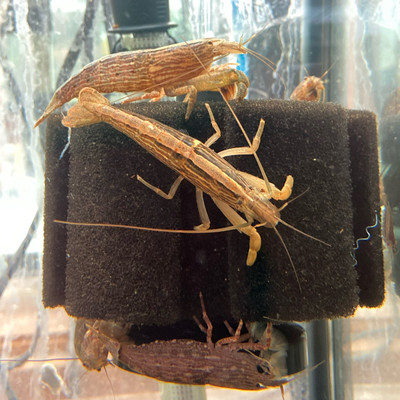Bamboo Shrimp
Posted by Max Gandara on on 23rd Apr 2025
Bamboo Shrimp: A Fascinating Addition to Your Aquarium
Bamboo shrimp, also known as Atyopsis moluccensis, are fascinating creatures that can be a unique and beneficial addition to your freshwater aquarium. These shrimp are known for their distinctive appearance and filter-feeding habits, making them a popular choice among shrimp enthusiasts and aquarists alike. In this blog, we'll explore the characteristics, care requirements, and benefits of keeping bamboo shrimp in your aquarium.
Characteristics of Bamboo Shrimp
Bamboo shrimp are native to Southeast Asia, particularly Indonesia and the Malay Archipelago. They are also commonly referred to as wood shrimp or fan shrimp due to their fan-like appendages used for feeding. Here are some key characteristics:
-
Appearance: Bamboo shrimp are relatively large compared to other aquarium shrimp, reaching up to 3-4 inches in length. Their bodies are typically reddish-brown with stripes, although colors can vary depending on their environment and diet.
-
Habitat: They are found in fast-flowing streams and rivers in the wild, where they use their fans to catch food particles from the water.
-
Lifespan: With proper care, bamboo shrimp can live for around 1-2 years in captivity.
Caring for Bamboo Shrimp
To keep bamboo shrimp healthy and thriving in your aquarium, it's important to provide them with an environment that mimics their natural habitat as closely as possible. Here are some tips for their care:
Tank Setup
-
Tank Size: A minimum of 20 gallons is recommended for housing bamboo shrimp, as they need ample space to move and filter-feed.
-
Water Flow: Provide a moderate to strong water flow using filters or powerheads to simulate their natural habitat and help them capture food effectively.
-
Water Parameters: Maintain a stable temperature between 72-82°F, with a pH of 6.5-7.5 and a hardness level of 6-15 dGH.
Diet and Feeding
Bamboo shrimp are filter feeders, relying on water flow to deliver food particles to their fans. Here are some dietary considerations:
-
Natural Diet: In the wild, they consume microorganisms, detritus, and organic particles.
-
Supplementing Diet: In an aquarium, you can supplement their diet with powdered foods, crushed fish flakes, or specially formulated shrimp foods. Ensure these foods are fine enough for their fans to capture.
Tank Mates
Bamboo shrimp are peaceful and can be housed with a variety of tank mates:
-
Compatible Species: Small, non-aggressive fish such as tetras, rasboras, and small catfish are good choices. Avoid larger, aggressive species that may harm or stress the shrimp.
-
Other Shrimp and Invertebrates: Bamboo shrimp can coexist with other shrimp species and invertebrates, provided there is enough space and food to support them all.
Benefits of Keeping Bamboo Shrimp
Apart from their unique appearance and behavior, bamboo shrimp offer several benefits to your aquarium ecosystem:
-
Natural Cleaners: By filtering food particles from the water, bamboo shrimp help maintain water quality and reduce organic waste.
-
Fascinating Behavior: Observing their filter-feeding and social interactions can be both educational and entertaining for aquarists.
-
Low Maintenance: Once established in a suitable environment, bamboo shrimp require minimal intervention, making them ideal for both beginner and experienced aquarists.
In conclusion, bamboo shrimp are a captivating species that can enhance the diversity and health of your aquarium. By understanding their needs and creating a supportive environment, you can enjoy the presence of these remarkable creatures for years to come. Happy shrimp keeping!

